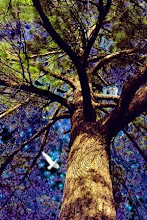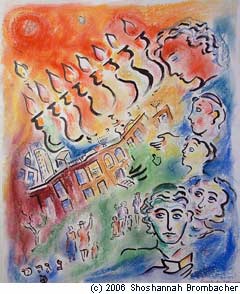Quantum Physics Made Fun
As a healer, I know the premise of 'What the Bleep?' is true: illuminating your consciousness can change your reality. By Diane Goldner
People are lining up to see it. Then, they return, again and again, and take their closest friends. They'll contemplate it deeply. They'll take concepts from it and sprinkle it in their daily life. I myself was "kidnapped" by friends to go see it and loved it. It described so many of my experiences as a healer and spiritual seeker. Of course, some people walk out before it is over, swearing it is ridiculous. Still, it's the surprise sleeper of the year. It's been held over in theaters in Los Angeles, Arizona, New York, and Washington State.
What is it? It's "What the Bleep Do We Know?!", a film about quantum physics. Quantum physics made fun. Quantum physics made relevant. Actually, you could say it's a film about reality. Or you could say it's a film about you, and how you create your life. It's done in a way that's fun, with psychedelic visuals, a good story line, great music, and good pacing.
While most movies these days portray events you wouldn't want happening to you-"What the Bleep?" is an exploration of the deepest existential questions, the ones most of us ask, sooner or later. These questions include: Who are we? Where are we going? Why are we here? And, What is reality? Why do we keep creating the same reality? Why do we keep having the same relationships? Why do we keep getting the same jobs over and over again? And, how can we make our reality better?
The movie is a series of interviews with leading quantum theorists, experts on the biology of emotion, and spiritual philosophers/counselors. Everyone has impressive mainstream credentials-professorships and/or degrees from top universities and major theoretical or practical discoveries to their credit-although there is one channeler, who could push buttons for some people who don't go in for that kind of thing. Nevertheless, every one of these talking heads is someone you might want to hang out with at a dinner party.
Then, inter-cut through the movie is another movie, the story of a photographer, Amanda, played by Marlee Maitlin, who learns first-hand how her thoughts create her reality. Ever since catching her husband in bed with another woman, she has hated weddings, churches, and men. She's addicted to pain medication. She's grumpy and somber while her houseguest is bouncy and light. Her boss describes Amanda's dilemma perfectly when he tells her: "You live in your past.... You have too many memories clouding your vision."
The movie takes us down one rabbit hole after another. That's easy to do since quantum physics is the ultimate mind-bender. This physics of the 20th and 21st century has found that the seemingly solid world in which we exist is made up almost entirely of empty space. As one of the physicists says, "In fact, there is essentially nothing to matter at all." Even the particles that make up the nucleus of an atom vibrate in and out of existence. As one of the founders of quantum physics once put it: "Atoms are not things, they are only tendencies. "
The closer you look, the stranger it gets. Experiments have found that particles can appear in two places at once. Plus the laws of the quantum domain suggest that there is no distinction between past and future. "It's only in conscious experience that we seem to go forward in time," explains one of the experts. "In quantum theory, we can also go backwards in time."
Perhaps the most dramatic aspect of quantum physics is that the consciousness of the observer affects the reality seen, even the outcomes of experiments. Not surprisingly, the overwhelming message of the movie is that our thoughts influence reality. In the choices we make, we collapse the wave of infinite possibilities into particles of experience.
One of the most vivid scenes of the movie shows photographs of water molecules that have been exposed to different thoughts and intentions. On a bottle of water on which the word "love" was written, the molecules formed beautiful crystals. Another bottle received the words, "You make me sick. I want to kill you." The water molecules are shapeless and sorry-looking.
Likewise, in a self-loathing moment, Amanda sees herself not as a beautiful curvaceous woman, but as grotesquely misshapen with huge hips and thighs. Then in an epiphany, she moves from self-loathing to self-love. In a beatific state, she draws all over her chest, arms and legs, a beautiful scrolling vine with hearts and the words, "I love you" growing out of it.
People who object to this movie claim it is dabbling in pseudoscience. It is true that many mainstream quantum physicists can't accept that the quantum laws govern humans, as well as quantum particles. But even the founders of quantum physics felt that quantum theory turned the world inside out and upside down. Today, while it is little known, experimenters at top universities such as Princeton University are finding that consciousness does influence the physical domain, even across time and space. It's not a strictly Newtonian world. The inside and the outside, the consciousness and the physical reality, are deeply related.
When, as a "rational" investigative journalist, I first began to have experiences of spiritual energy and how powerful it can be, it was my physics professor (I was taking physics at a local college) who encouraged me to read about quantum physics. Is that irony? Or perfection? As a healer, I now live in a world where the things claimed by quantum physics are part of my moment-to-moment experience, where illuminating someone's consciousness can truly change that person's reality. For me, quantum physics is only describing a level of reality that is always there. You can call it the quantum domain or the spiritual domain. At the very least, as the movie suggests, these domains are intimately related.
If I have any caution about this movie, it's that the subject is so vast that at times the movie, while a terrific overview, could be accused of being glib about how easy it is to change one's consciousness. The relationship between consciousness and reality is complex, to say the least. I'd love to see a sequel that deals with more of the actual mechanics of transformation. Nevertheless, I found "What the Bleep" to be profound. It's also a lot of fun. And everything in it? Well, as one of the scientists suggest, "Don't just take it at face value. Test it and see if it is true."
Diane Goldner, a healer and writer based in Los Angeles and New York, is the author of 'How People Heal: Exploring the Scientific Basis of Subtle Energy in Healing' (Hampton Roads, 2003). She can be reached at www.howpeopleheal.net or dianegoldner@msn.com.







